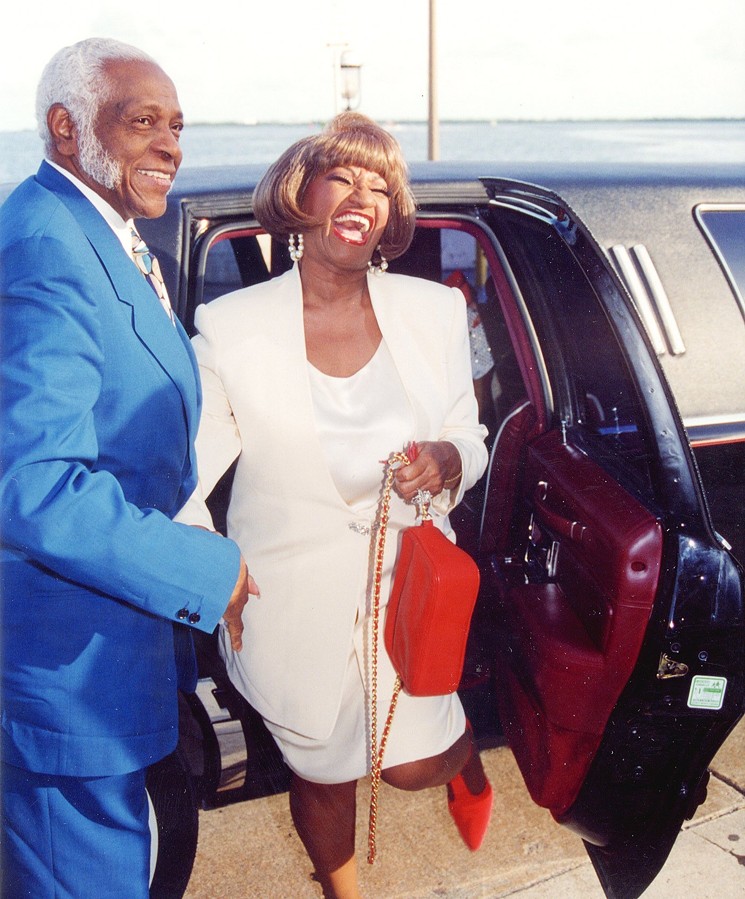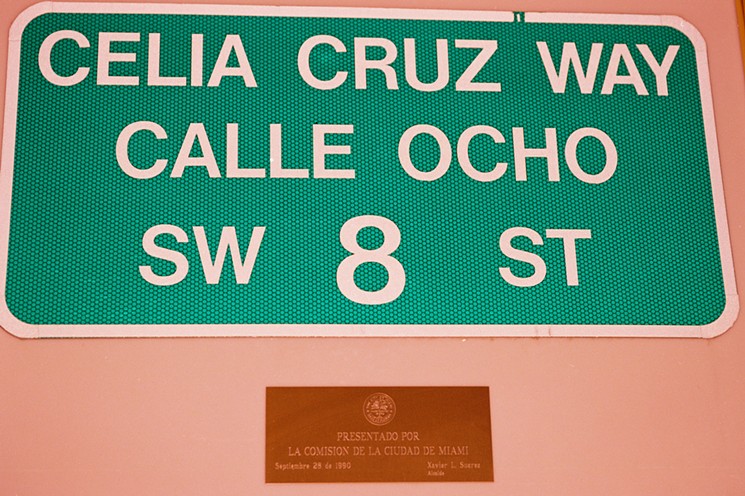Celia Cruz was an artist as well known for the props that adorned her body as for the music she released during her storied career. At the mention of her name, her colorful wigs, bejeweled shades, and sequined dresses come to mind as easily as her signature catchphrase, "¡Azúcar!" Thanks to the elaborate decor that festooned her frame, Cruz's songs — the soundtrack to all milestone celebrations of the Cuban exile community for the past half-century — were not only heard but also seen.
That was the intent of the "Queen of Salsa," who, decades before the advent of social media and multimedia stagecraft, understood the importance of making an indelible mark on the minds of her audience through sound and sight. Now, 15 years after her death, local tributes — including an exhibit and a musical — will highlight the interplay between her music and visuals, and how they continue to keep her memory alive for millions of fans across the globe.
On Saturday, October 20, the American Museum of the Cuban Diaspora will open "Forever Celia," the largest exhibition of artifacts from Cruz's life and work. The scale of the show will surpass that of the 2005 Smithsonian exhibit on the singer's life, which later went on display at the Bass in Miami Beach. Whereas the prior exhibit focused largely on Cruz's artistry, this display concentrates on more personal aspects of her life, says Omer Pardillo-Cid, executor of the Celia Cruz Estate and the singer's former manager.
Personal effects, including items from her home such as her desk and passport, will be on display at the exhibit, and large-scale installations will memorialize moments that Cruz personally considered to be highlights in a career filled with landmark achievements. Among them is a re-creation of her visit to the Guantánamo Bay Naval Base.
Cruz famously left Cuba in 1960 shortly after the ascension of Fidel Castro. The government there denied her reentry in 1962 after her mother's death, and the closest she came to returning home were her two visits to the American base in Guantánamo in the '90s.
Video of her first visit will be shown at the museum, specifically the moment when Cruz, flanked by Cuban military escorts, reached underneath the fencing that separated the American and Cuban sides of the island to grab soil from her homeland. "She brought back that soil to the U.S.," Pardillo-Cid remembers. "She gave a few little bags to friends, and then she kept it always in her house." Her family and friends buried Cruz with that soil, as was her request. The museum's installation will include fencing similar to that which continued to separate her from her homeland even as she stood upon it.
Cruz's native Cuba has long been thought of as an island stuck in time — a perception buoyed by images of midcentury cars running on repurposed motor parts and crumbling homes handed down from generation to generation. But the Cuba that Cruz left behind has undergone notable changes over the past few years. Fidel Castro is dead, and his successor, brother Raúl, is no longer in power. And although changes have been scaled back by the Trump administration, the United States and Cuba took strides to normalize diplomatic relations in the twilight of the Obama years.
But the scars of a half-century in exile cannot be easily healed, and Cruz's music — exuberant in the face of generational pain — has taken on new resonance as the younger Cuban generation finds that visits to the motherland can never fully restore what their parents and grandparents lost decades ago.
That music takes the forefront in Celia: The Musical, showing at the Arsht Center for a two-day run one month after "Forever Celia" opens. In sharp contrast to the exhibit, the musical keeps the use of onstage props to a minimum. Though Spanish-Cuban singer Lucrecia re-creates Cruz's signature outfits as the lead in the musical, writers Gonzalo Rodriguez and Jeffry Batista, along with Pardillo-Cid, the musical's executive producer, opted to place just Lucrecia and the band onstage for the most part, backed only by an innovative LED display showing many of Cruz's personal items while the story of her life unfolds onstage.
In the musical, Cruz is still alive, and she puts on a concert in the present day. Pardillo-Cid says this was the most effective way of expressing the ultimate message of all of the Cruz Estate's projects: that Cruz's music is timeless and will retain its relevance for decades to come. "She used to tell me: 'Omer, yo no quiero que aunque yo no esté en el mundo, mi música se muera.' She wanted always to live, to be remembered."
Though Cruz never lived in Miami, she forged a deep bond with the city that became a second home to millions of exiles like herself. The coming exhibit, musical, and additional commemorative events are proof the Magic City has never forgotten her. Earlier this month, the eighth-annual Orgullo Festival — Miami Beach's Hispanic LGBT pride festival — dedicated its two-week extravaganza to Cruz, with events including a screening of the documentary Celia the Queen and the fundraising gala Night of a Thousand Celias.
"Celia always had a Miami connection because she was Cuban, and I think Celia represented the exile community very well at a very high standard," Pardillo-Cid says. "So Miami is Celia, and Celia is Miami... I always say that she was a black woman, poor, who left a small island and conquered the world only with her music."
UPDATE: A previous version of this story listed an incorrect opening date for "Forever Celia."
"Forever Celia." Saturday, October 20, through March 31, 2019, at the American Museum of the Cuban Diaspora, 1200 Coral Way, Miami; 305-529-5400; thecuban.org. Admission costs $12.
Celia: The Musical. 8 p.m. Friday, November 16, and Saturday, November 17, at the Adrienne Arsht Center for the Performing Arts, 1300 Biscayne Blvd., Miami; 305-949-6722; arshtcenter.org. Tickets cost $59 to $159.
[
{
"name": "Air - MediumRectangle - Inline Content - Mobile Display Size",
"component": "19274298",
"insertPoint": "2",
"requiredCountToDisplay": "2"
},{
"name": "Editor Picks",
"component": "17482312",
"insertPoint": "4",
"requiredCountToDisplay": "1"
},{
"name": "Inline Links",
"component": "18711090",
"insertPoint": "8th",
"startingPoint": 8,
"requiredCountToDisplay": "7",
"maxInsertions": 25
},{
"name": "Air - MediumRectangle - Combo - Inline Content",
"component": "17482310",
"insertPoint": "8th",
"startingPoint": 8,
"requiredCountToDisplay": "7",
"maxInsertions": 25
},{
"name": "Inline Links",
"component": "18711090",
"insertPoint": "8th",
"startingPoint": 12,
"requiredCountToDisplay": "11",
"maxInsertions": 25
},{
"name": "Air - Leaderboard Tower - Combo - Inline Content",
"component": "17482313",
"insertPoint": "8th",
"startingPoint": 12,
"requiredCountToDisplay": "11",
"maxInsertions": 25
}
]














